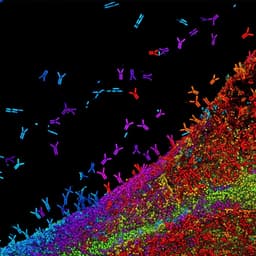
Earth Sciences
Revised Storegga Slide reconstruction reveals two major submarine landslides 12,000 years apart
J. Karstens, H. Haflidason, et al.
Discover the groundbreaking research by Jens Karstens, Haflidi Haflidason, Christian Berndt, and Gareth J. Crutchley, unveiling the secrets of the Storegga Slide and the previously unnoticed Nyegga Slide. This research reveals the implications for sediment displacement and tsunami hazards in the North Atlantic, suggesting more frequent large slope failures at the mid-Norwegian margin. Don't miss out on these crucial findings!
Playback language: English
Introduction
The Storegga Slide, a massive submarine landslide off the mid-Norwegian coast, is a significant event in geological history, known for generating a devastating tsunami approximately 8,150 years ago that impacted coastal areas across northern Europe. Previous studies estimated the slide's volume at 2400–3200 km³, with the initial phase involving the removal of up to 50–70 m of sediment from the northern scar, contributing significantly to the total volume. These studies suggested a multi-phased process, beginning with a downslope failure that progressively moved upslope, followed by lateral spreading and a final central segment failure responsible for the tsunami. Radiocarbon dating places the main Storegga Slide event around 8150 years BP. However, this understanding is based on incomplete data and interpretations. The current study aims to revise the existing reconstruction of the Storegga Slide by incorporating new geophysical and sedimentological data focusing on the northeastern region. This research directly addresses a key gap in our knowledge of large-scale slope failures, specifically the frequency of such events and their implications for tsunami hazard assessment in the North Atlantic. A more accurate understanding of the Storegga Slide complex is crucial, not only for comprehending the geological history of this area but also for refining our capacity to model and predict future tsunami hazards stemming from similar events on continental margins worldwide. The identification of any earlier phases would fundamentally shift our understanding of the event's scale and recurrence rate, providing critical insights into the long-term dynamics and hazard potential of this region. The study's importance extends beyond regional concerns, serving as a valuable case study for global assessments of submarine landslide hazards and their consequences.
Literature Review
Numerous studies have investigated the Storegga Slide, providing insights into its morphology, mechanisms, and tsunami impact. Haflidason et al. (2004) detailed the slide's architecture and geometry, proposing a multi-phase development. Bryn et al. (2005) focused on explaining the slide's occurrence, highlighting potential triggering mechanisms. Micallef et al. (2009) analyzed mass movement processes in the northeastern section. Løvholt et al. (2005) modeled tsunami generation from submarine slides in the Storegga area. Haflidason et al. (2005) established the slide's dating and morphometry, placing the main event around 8150 years BP. Several studies documented the tsunami's impact along various coastlines (Bondevik et al., 2005; Wagner et al., 2007; Romundset & Bondevik, 2011; Fruergaard et al., 2015). However, these studies often relied on limited data coverage, particularly in the northern region, leading to potential biases in the overall reconstruction of the event. The literature clearly establishes the Storegga Slide as a major geological event with significant implications for tsunami hazard assessment. However, the limited data coverage, specifically in the northeastern region, points towards a potential for significant revisions to the existing model.
Methodology
The study utilizes a combined approach of geophysical and sedimentological analyses. High-resolution sediment echosounder profiles were acquired during research cruise M87/2 using a Teledyne Parasound system. These profiles provide detailed images of the subsurface stratigraphy, enabling the identification of mass transport deposits and discontinuities. The bathymetric dataset integrated data from various sources, including Norsk Hydro AS, the Mareano database, and 3D seismic seafloor picks. The data were processed and interpreted using Kingdom Suite and Petrel software. Sediment core analysis, primarily from the Ormen Lange Project, was re-evaluated. Seven cores were analyzed in detail, focusing on radiocarbon dating. The radiocarbon dates were corrected using the Marine20 dataset to obtain calendar ages. The analysis focused on integrating the echosounder profiles and core data to establish a robust chronostratigraphic framework, revealing the presence and characteristics of the Nyegga Slide. Key reflections in the echosounder profiles (R1-R8) were correlated with known age horizons from sediment cores, providing accurate temporal constraints on the sedimentary layers and mass-transport events. The study involved careful comparison between intact sidewall stratigraphy and the slide scar infill to determine the thickness of sediments removed during both the Nyegga Slide and the Storegga Slide. By correlating the various datasets, the researchers built a revised stratigraphic model of the Storegga Slide complex, incorporating the newly identified Nyegga Slide. The comparison of the stratigraphic thickness between the intact sidewall and the slide scar, utilizing a reference surface (R8), allowed the estimation of the sediment volume removed during the Nyegga Slide. This methodology allowed for a comprehensive re-evaluation of the Storegga Slide and the inclusion of the previously unidentified Nyegga Slide in the overall history of this massive slope failure.
Key Findings
The key findings of the study revolve around the discovery and characterization of the Nyegga Slide, a previously unknown large-scale slope failure that predates the Storegga Slide by approximately 12,000 years. Analysis of high-resolution sediment echosounder profiles revealed an acoustically transparent mass-transport deposit (MTD) interbedded with well-stratified sediments, interpreted as the Nyegga Slide MTD. This MTD has a thickness of up to ~15 m and extends from the sidewall to a seafloor crack. The age of the Nyegga Slide is constrained to approximately 20,000 years BP, based on the position of the MTD within the established chronostratigraphic framework. Detailed analysis of sediment cores confirmed the presence of post-Last Glacial Maximum (LGM) sediments beneath the Storegga Slide discontinuity, implying that significant sediment removal had occurred before the Storegga Slide. Comparison of sidewall and slide scar stratigraphy indicated that the Nyegga Slide removed at least 35 m of sediment, significantly revising previous estimates of sediment evacuation during the Storegga Slide. This revised assessment suggests that the Nyegga Slide affected at least 20 m of the sediment column and potentially more, indicating a considerably larger event than initially thought. Combining the echosounder data with sediment core evidence, the study estimates a minimum sediment removal of 35 meters during the Nyegga Slide, previously misattributed to the Storegga Slide. Furthermore, the presence of post-LGM sediments beneath the Storegga discontinuity in some cores further supports the existence of the earlier Nyegga Slide, demonstrating a two-phase failure history. The study also presents evidence that suggests a large slope failure at the end of the LGM along the southern slide scar segments as well, although further investigation is needed to determine if this was a separate or simultaneous event. The estimated volume of the Nyegga Slide, based on the percentage of the northern slide scar evacuation attributed to it, is similar to other known large-scale slides. The revised reconstruction of the Storegga Slide complex dramatically reduces its volume compared to previous estimates, but still accounts for the observed tsunami.
Discussion
The discovery of the Nyegga Slide fundamentally alters our understanding of the Storegga Slide complex and its associated tsunami hazard. The finding of a significant slope failure approximately 12,000 years before the Storegga Slide event necessitates a reassessment of the frequency and magnitude of such events along the mid-Norwegian margin. The revised reconstruction suggests that large-scale slope failures occur more frequently than previously thought, implying a higher recurrence interval and a potentially increased tsunami hazard. The reduction in the estimated volume of the Storegga Slide itself does not contradict the observed tsunami effects, as the deeply incised central slide segment, considered the primary source of the tsunami, remains largely unaffected by the revised model. While the study focuses on the northeastern region, evidence from sediment cores in the southern region suggests that the Nyegga Slide may have been a more widespread event than initially anticipated, affecting the entire Storegga Slide scar area. The increased frequency of large-scale slope failures calls for a comprehensive reassessment of geohazard assessments based on previous Storegga Slide insights. Moreover, the identification of preconditioning factors, such as gas hydrate dissociation, elevated pore pressure, and ice-sheet dynamics, amplifies the need for continued research into the complex interplay of geological and climatic factors that contribute to slope instability on continental margins.
Conclusion
This study presents compelling evidence for a previously unknown large-scale submarine landslide, the Nyegga Slide, which significantly predates the well-known Storegga Slide. The discovery necessitates a revision of the Storegga Slide's history and its implications for tsunami hazard assessment. The revised model reduces the Storegga Slide's volume but maintains its significance as the main contributor to the 8150 BP tsunami. The more frequent occurrence of major landslides suggests an increased risk of tsunamis in the North Atlantic, highlighting the need for refined risk assessments and updated tsunami models. Future research should focus on further investigating the extent and mechanisms of the Nyegga Slide, as well as the complex interplay of factors that led to these large-scale slope failures. A more detailed investigation of the southern slide scar segments is also crucial to refine the understanding of the Nyegga Slide's regional extent and its potential to generate tsunamis.
Limitations
The study's primary limitation is the relatively limited spatial coverage of the high-resolution echosounder data and sediment cores. While the data provide strong evidence for the Nyegga Slide in the northeastern region, further investigations are required to fully ascertain its extent across the entire Storegga Slide scar. The limited number of cores that penetrated the Storegga discontinuity might limit the precision of the volume estimates. Additionally, while the study suggests preconditioning factors that played a role in the Nyegga Slide, a more comprehensive investigation into the precise triggering mechanisms is needed. Future research should expand on the dataset to refine our understanding of these events and accurately estimate the hazard they pose.
Related Publications
Explore these studies to deepen your understanding of the subject.







